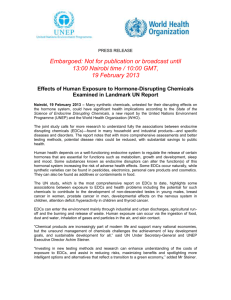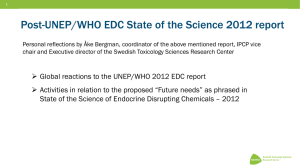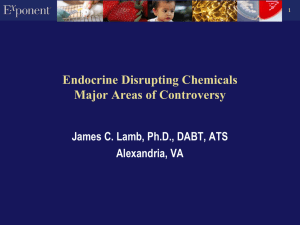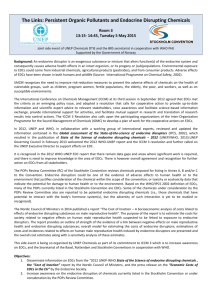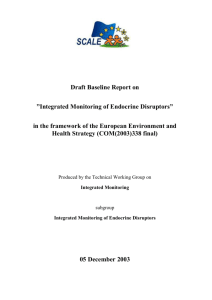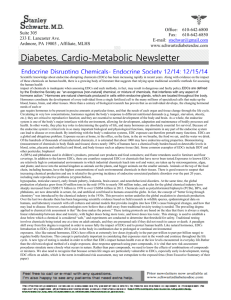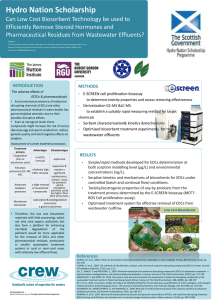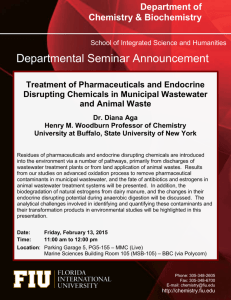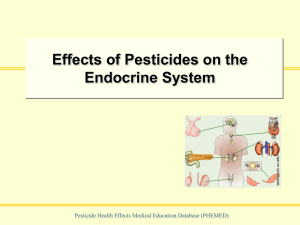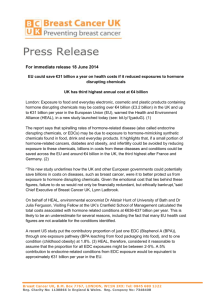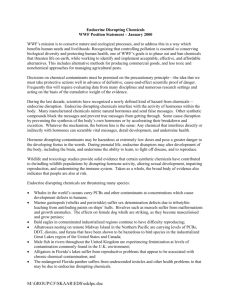UNEP AG/EDC/1NF 2.3 Advisory Group for UNEP Endocrine
advertisement
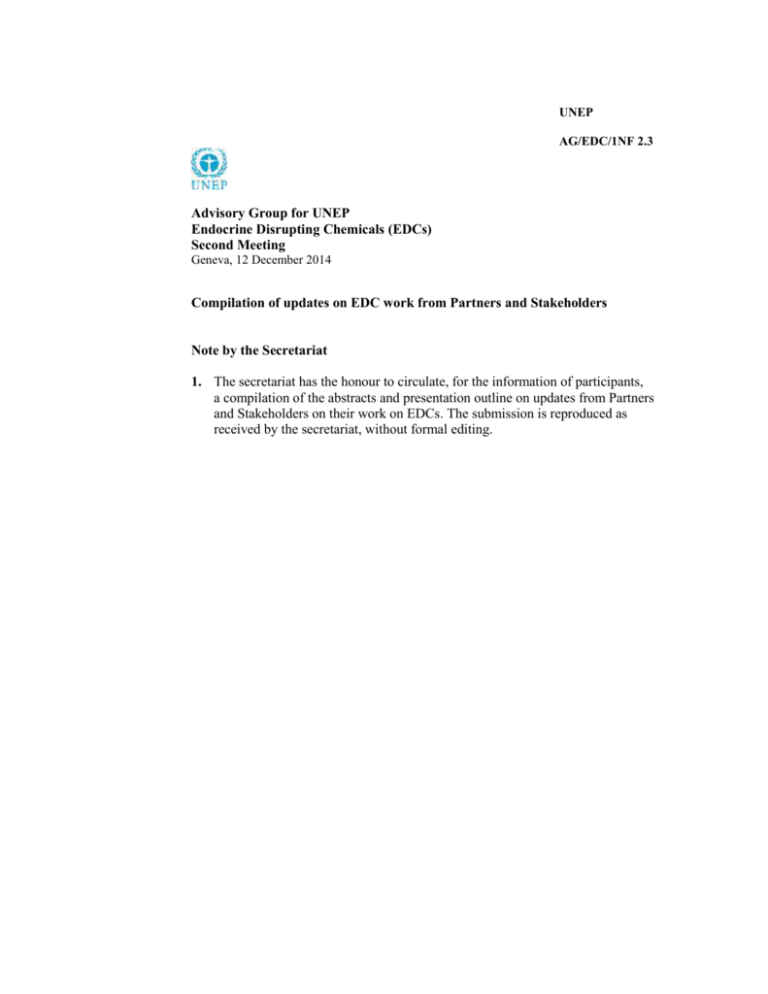
UNEP AG/EDC/1NF 2.3 Advisory Group for UNEP Endocrine Disrupting Chemicals (EDCs) Second Meeting Geneva, 12 December 2014 Compilation of updates on EDC work from Partners and Stakeholders Note by the Secretariat 1. The secretariat has the honour to circulate, for the information of participants, a compilation of the abstracts and presentation outline on updates from Partners and Stakeholders on their work on EDCs. The submission is reproduced as received by the secretariat, without formal editing. 1. US Environmental Protection Agency “Overview of US EPA Endocrine Disruptor Program Activities: High Throughput Chemical Screening for Endocrine Disrupting Potential” David Dix, US EPA, Washington, DC The US Environmental Protection Agency (EPA) Endocrine Disruptor Screening Program (EDSP) uses a two-tiered approach to determine a chemical’s potential to interact with estrogen, androgen, and thyroid (EAT) hormone pathways in humans and/or wildlife. Requirements for testing, data review, and weight of evidence determination require substantial temporal, financial, animal, and human resources. Currently, more than 10,000 chemicals are in use and 100s of new chemicals are introduced every year, necessitating a more rapid method for screening the “chemical universe”. To address this need, EPA is leveraging in vitro and in silico computational tools to identify potential interactions with EAT pathways. These data will be evaluated in a hypothesis-driven, adverse outcome framework, proposed to the OECD Adverse Outcome Pathway Workgroup as a harmonized conceptual approach. Resulting hazard identification data will be coupled with estimates of physiologically and environmentally relevant exposure data to produce an integrated and exposure ranking (IBER) to prioritize chemicals for EDSP screening. This approach facilitates rapid identification of endocrine disrupting chemicals that are likely to have the greatest potency and pose the greatest risk to human and environmental health. (This abstract does not necessarily reflect EPA policy) 2. International POPs Elimination Network “Working towards global awareness and action on EDCs” Joe DiGangi, IPEN IPEN works both on the ground and within international policy and scientific arenas to raise awareness and reduce and eliminate human exposure to toxic chemicals. Due to strong interest from IPEN’s Participating Organizations around the world, IPEN established an international NGO working group on EDCs in 2011. One goal is to apply the solid experience gained in global monitoring of POPs and mercury to EDCs and utilize this scientific data as a critical awarenessraising tool to elevate the profile of EDCs among the public, media and policy-makers. After ICCM3 adopted EDCs an emerging policy issue, IPEN and the Endocrine Society worked together to develop a flagship awareness-raising report highly relevant to developing and transition countries; Introduction to Endocrine Disrupting Chemicals (EDCs): A guide for public interest organizations and policy-makers. Overall, the presentation will outline IPEN’s experience and potential for global work on EDCs as science reveals the significant challenges EDCs pose to human health, the environment and future generations. 3. Nordic Council of Ministers “The Cost of Inaction: A socio economic analysis of costs linked to effects of endocrine disrupting substances on male reproductive health” Rikke Donchill Holmberg, Danish Ministry of Environment, Environmental Protection Agency Exposure to endocrine disruptors is suspected to lead to a number of negative effects on human health and for wildlife, including decreased fertility, increased occurrence of hormonally-related cancers, behavioral changes, metabolic disorders like obesity and diabetes and suppression of the immune system. However, the scientific evidence of a causal link between exposure and negative effects is not equally strong in all cases. In the ‘Cost of Inaction’ report, focus is on negative effects on humans for which the causal link between exposure to endocrine disruptors and negative effects is relatively well established, i.e. negative effects on male reproductive health (cryptorchidism, hypospadias, poor semen quality and testicular germ cell cancer). It must be acknowledged that the costs estimated in this report therefore represent only a fraction of the potential total costs of exposure to endocrine disruptors. The strength of the evidence between exposure to endocrine disruptors and the effects on male reproductive health seems convincing when the biological plausibility is combined with human epidemiological and case studies, effects observed in wildlife and effects observed in laboratory animals exposed to endocrine disruptors. It is, however, not the focus of the present report to document the strength of the evidence. That exposure to endocrine disruptors leads to negative health effects in human populations is thus a basic assumption of this report, and for discussions of the strength of the evidence, reference is made to major review reports within the field, including the WHO/UNEP report, State of the Science of Endocrine Disrupting Chemicals (WHO/UNEP 2012). Throughout the paper, costs of illness - which is the same as the monetary benefit of reducing risks – are discussed. The cost estimates in this report are mainly valid for the Nordic countries and extrapolation of these results to other countries, including EU 28, is associated with increasing uncertainty. Link to the report at the Nordic Council of Ministers website: http://dx.doi.org/10.6027/TN2014557”
